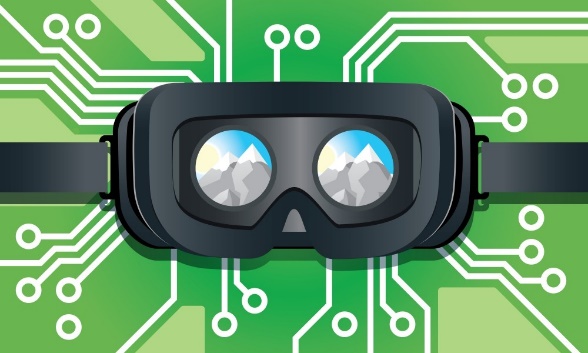The 6 hottest learning trends for 2018 - Part 1: Augmented Reality (AR) and Virtual Reality (VR)
/This is Part 1 in our series on the 6 hottest learning trends for 2018 blog post series. In case you didn’t catch it last month, we posted an article on the 6 hottest learning trends for 2018. Over the next couple of months we’ll be sharing our ideas, strategies, tools and ideas with you on each of the six learning trends. So stay tuned...
What are AR & VR?
What do you think of when you hear the words “augmented reality”? What about “virtual reality”? Chances are the first picture that pops into your head is a giant helmet apparatus, or maybe that video game you and your friends can’t stop playing. For many of us, AR and VR occupy the same vague territory—we know this technology exists but we’re not sure where it fits in or what to do with it. But increasingly, we’re encountering it in our daily lives. In a nutshell, with AR the learner is in a real environment with artificial enhancements (“adding to the real world”) while in VR, the learner is in a completely artificial environment.
How are they used?
AR and VR are transforming the way we interact with each other using software and hardware that create immersive environments. Take Google Translate, the go-to app for anyone confronted with a message written in a foreign language. Not only can you cut and paste your mysterious text into Google Translate; you can take a picture of it—that’s where AR comes in as your phone translates the text on the spot.
Or how about the Amikasa, the app that lets you walk around your home placing virtual pieces of furniture to design your optimal space?
Your first thought may be: those are fun. I can read museum signage in Barcelona or see how my couch looks against the window without having to lug it there. But there are also educational applications for AR. You’re training a new employee how your company warehouse is organized. Or building real-time instructions for students learning a complex, hands-on task. Or exposing the hidden wires behind the image of a wall. Or embedding holographic help messaging in an apprentice’s workspace—all visible with a smartphone camera.
L&D professionals agree that AR is here to stay and will become increasingly important in the coming years. The ability to map instructions and information onto the real world can enhance how a learner interacts with it, reinforce learning and memory, and reduce employee time-to-productivity. AR brings information to the learner, where they are and when they need it.
So how is VR different from AR? If augmented reality brings information to you, virtual reality brings you to information. VR places the learner in a simulated environment where they can practise skills without real-world risk, learning in a context that approximates the context they need to work in. Some good examples of VR are a new pilot in a simulated airplane cockpit learning how to fly or a tactical SWAT team learning the nuances of hostage negotiation in a virtual reality environment, new surgeons conducting surgical procedures and a high-fidelity 3-D simulation that allows data analysts to check on machinery, test readings on dials and survey the outside of an installation—all from a web-based simulation. Multiple senses are engaged, producing immersive experiences with lasting resonance and high learning potential.
Tools to create AR & VR
Creating AR learning is as easy as downloading one or more of a host of tools available online including rapid authoring tools and stand-alone AR development tools (many free) such as. Layar, Aurasma, Zapworks, Eon Creator AVR, ARToolKit (open-source) and AugmentedPRO. How L&D professionals go about creating learning is always evolving, so if you’ve tried any of them we’d love to hear from you; be sure to drop us a line.
Whereas AR usually requires a smartphone or tablet, VR can require a more technical set-up. Fully immersive, interactive headsets are expensive. A relatively less costly approach is 360 video (e.g., Mars Rover), viewable through Cardboard ($19.99 CAD) or another VR viewer such as Oculus Rift ($529 CAD). (The Tech Edvocate has a good list of VR apps.) Tools such as Sketchfab and iStaging, with subscription plans ranging from free to enterprise-level), allow you to work with 3D content for web, mobile, AR and VR. More advanced options include the Unity engine (also subscription, from a basic $0 plan to a Pro $125 CAD/month plan) used to create 2-D and 3-D experiences across many platforms, and many others. Even with the less expensive tools, your videos do need to be edited, and that can consume time and resources.
Who’s using AR & VR?
Many organizations have been using AR and VR for learning, including:
UPS uses VR to train its truck drivers.
European Hospital Georges Pomidou teaches surgical students how to perform a total hip replacement using VR (Oculus Rift).
Primary school students in Ireland use VR to re-create and visit Irish historical sites.
NASA uses VR to prepare astronauts for upcoming missions.
At Boeing, workers who assemble intricate wire harnesses that transmit signals and electrical power in planes are using AR headsets. Assembly time has been cut by 25% and the error rate has been reduced to nearly zero.
In an article from the Harvard Business Review, Augmented Reality Is Already Improving Worker Performance, this video “shows a side-by-side time-lapse comparison of a GE technician wiring a wind turbine’s control box using the company’s current process, and then doing the same task while guided by line-of-sight instructions overlaid on the job by an AR headset. The device improved the worker’s performance by 34% on first use.”
Are they fads?
Industry experts say no. VR is by far more costly than AR, requiring high-tech headsets and sometimes body sensors, which may make it cost-prohibitive at the moment. In contrast, AR is a great fit for learning and performance support as well as being cost-effective and easy for learners to access. AR is happening right now for anyone who has a smartphone, and it’s not just for catching Pokémon, although it’s pretty darn good for that. Quoting from a February 2018 eLearning Learning blog article on Virtual Reality and Augmented Reality, “There’s still lots of room for these technologies to grow and develop. But as prices go down and the technology gets easier to use, we’ll probably see more of them. Video and mobile learning used to be expensive and rare, and now look at them. They’re everywhere”.
So what kinds of applications do you see for AR and VR? Are you using either? Both? And have they changed the way you approach learning and development? Send us a comment and tell us what you’re doing!
Click here for Part 2 in our blog post series of the 6 hottest learning trends for 2018.










